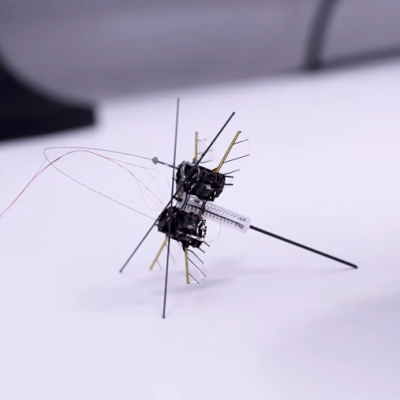Most robots depend on controlled environments, because the real world is hard to get around in. The smaller the robot, the bigger this problem because little wheels (or legs) can take only little steps. One way around that is MIT’s latest one-legged hopping robot, which sports a set of four insect-like wings on its top end and can quickly pogo-hop its way across different terrain with ease.

The wings aren’t for flying in the usual sense. They provide lift, but also help the tiny device steer itself so that its hops land precisely. Earlier incarnations of one-legged hopping robots (like this one) accomplished this with propellers and electric motors, but traditional motors are a non-starter on a device that weighs less than a paperclip.
Right now, this little winged hopper is not completely self-contained (power and control systems are off-board) but running it as a tethered unit allows researchers to test and evaluate different, minimalistic ways for a machine to move around efficiently. And efficiency is the whole goal of going in this direction.
Certainly tiny flying drones already exist and get about in the real world just fine. But if one wants to shed mass, ditch conventional motors, and reduce cost and power consumption, this tiny winged hopping machine is one way to do it. And it can even carry payloads! The payloads are tiny, of course, but being able to haul around ten times one’s own weight and still function reliably is an impressive feat.
You can watch it in action in the video embedded just below the page break. Once you’ve watched that, we’d like to remind you that novel locomotion isn’t just the domain of hopping robots. Tiny robots with explosive joints is just as wild as it sounds.
















If only it was able to stand itself upright after tiping over for whatever reason…
That video was clearly semi-professionally produced and was amazingly awesome especially compared to the usual garbage YouTube productions. It was tight, to the point, short, and shows alllll the good stuff you want to see. More of this please. That robot is super cool!
If science funding continues to be a thing in the US, maybe labs should budget some money to make videos like this. The entire department or institution should have a professional service that does this for funded projects. Then the public can actually see and get excited about what they are paying for. This was like watching a 5 minutes NOVA segment or something. A+
Early-career scientist here (what they usually call a “PhD candidate”), and I couldn’t agree more. The modern world gives us so many opportunities to communicate our research with the general public, and we’re all failing so badly to even give it an honest try. My work is in cyber-physical systems, and a theme in a lot of my work is getting more performance out of inexpensive hardware, so a lot of what I do would probably be of interest to the electronics hobbyist community. Yet few of my colleagues seem to even acknowledge this community’s existence, let alone make any direct attempts at doing outreach.
And as someone who’s pretty good on a pogo stick, the robot’s pretty cool too. 😎
Some unsolicited advice. When I was in graduate school I won every annual research forum I participated in and it wasn’t because my science was the best (it wasn’t). I approached every presentation with the mentality that I needed to explain it to my mom, who is not at all a science person and is a retired elderly woman Then I practiced till I could do it in my sleep. Then ran it by..my mom.
Even when explaining stuff to people in your own field the science needs to be accessible.
Like it or not communicating science is an integral part of science these days – arguably more important than the science itself because if you can’t get funding you can’t do science.
These days I amuse myself by doing grade school and high school outreach and most kids I talk to can have a decent understanding of my thesis in short order.
This is engineering, not science though.
The typical research lab-style thinking is, money!
Spend five years working on some project, write big long papers, submit the papers to some pay-walled site, and the project to someone who never lets it see the light of day.
But, if it’s something that would make people’s lives better, why hide it from the world? Or, maybe one of us geeks/nerds might have some idea how to refine some aspect of it (better jump height management, laser distance measurement, anything you might think of)… can we submit those ideas to the people working on these projects? Because, I’m sure there must be at least one person who reads these articles who might have some idea for it.
I don’t share the optimism of the commenters here. What is the point of this project? Something that weighs a paperclip will be useless outdoors and I struggle to see what it can do indoors. I have seen so many articles and TV footages of robots since the 80s and all got forgotten and we are always somehow 10 years away from usable household robots. If I had a cent for every MIT organic and soft robot projects, I’d be a millionaire. Even Boston Robotics keeps demoing their thethered robot dogs for 15 years and it’s not even close to be used as anything remotely practical.
By the way, the microcombustion robots are fascinating (and loud)!